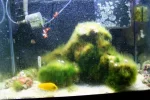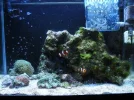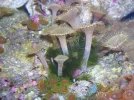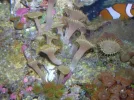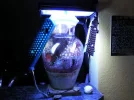brandon429
pico 1
Peroxide.
It works, and you don't have to chase perfect tank params to starve the algae, the old school way that obviously doesn't work.
If you want to use an all natural method such as snails and water purification only to starve algae, then this isn't the thread for you.
But if you want all your algae dead by Monday so you can start fresh, then this is the thread for you.
The problems you will read with peroxide dosing come from adding it to the whole tank. There are about 10 better ways to use it, and these work 100% on any tank, so its the best algae remedy I have ever seen, in a decade of chasing a zero algae tank using every method ever written online in the forums.
The spot treatment:
drain your tank down for a large water change, preparing to match specific gravity and temp upon refill. wherever the algae is exposed, dropper a couple drops straight 3% peroxide right on the algae. let sit for 2 mins exposed, then refill the tank, the algae will die white by monday but more likely by the end of today, that fast.
the out of tank treatment
remove a problematic rock, and spot treat outside the tank if you can't or won't drain your tank, same outcome
cyano/bryopsis covered areas
use peroxide in a spray bottle, and use the bare minimum in sprays to cover the area, let sit for two mins outside the tank or in a drained tank, refill, problem gone.
The only downside to this method is that decorative macro algaes in the main tank can be wiped out, peroxide hates unicellular organisms (but not filter bacteria) so if you keep decorative macros only do the treatments outside the main tank and rinse well before installing, then it won't hurt the macro. Coralline can be bleached with peroxide, but who cares its only on the spot you treat it won't affect the other coralline.
here's a proof thread Im linking, with tons of before and after pics
Peroxide saves my Tank! With pics to Prove It! - Nano-Reef.com Forums
The common bandwagon responses against peroxide use are:
-if you don't stop the source, it will just come back
-it will kill your filter bacteria
both untrue. Algae will always grow unless you take ultimate measures to purify your water and remove all phosphates and most or all nitrates, that's one option. The other option is to not headache yourself with all that, keep the water params within coral-growing params which basic water changes will accomplish, and spot kill the algae. In direct contradiction to that statement, my algae does not grow back faster. It grows back once every 3 months, and two drops of peroxide are worth the 20 seconds it takes to prevent algae for the next three months, its the best algae remover Ive ever seen and my tank is the cleanest its ever been.
The filter bacteria aren't catalase producers, they don't bubble in contact with peroxide (like the bacteria in the palm of your hand when you hold peroxide in it and it does nothing, those bacteria are unaffected by peroxide at 3% for the short intervals we use)
the bacteria in your ear that bubble are anaerobic catalase producers melded in ear wax, they are affected by peroxide, it is not a wide spread antibiotic as many assume, and its 100% harmless to your reef if used as a non systemic doser.
So, enjoy your algae free tanks its easy to cure any situation from string diatoms, to persistent cyano, in a way that actually works and doesn't rely on methods twenty years tested and inconsistent among tank keepers.
3% peroxide spot applied to any algae variant of any kind will kill it in one day, hows that for consistent lol
post before and after pics if you run it so we can start the proof here for this forum. Peroxide is the ace of spades you didn't know, I'll hang around to respond to any tests we can run to prove this.
B
here's simple proof, Reefmisers pics from that thread he said I could post. The peroxide gave him a fresh do over so that he could use more conventional methods to control its come back. The tank is running perfect so far, the peroxide did exactly what it is known to do when used as a spot treatment
It works, and you don't have to chase perfect tank params to starve the algae, the old school way that obviously doesn't work.
If you want to use an all natural method such as snails and water purification only to starve algae, then this isn't the thread for you.
But if you want all your algae dead by Monday so you can start fresh, then this is the thread for you.
The problems you will read with peroxide dosing come from adding it to the whole tank. There are about 10 better ways to use it, and these work 100% on any tank, so its the best algae remedy I have ever seen, in a decade of chasing a zero algae tank using every method ever written online in the forums.
The spot treatment:
drain your tank down for a large water change, preparing to match specific gravity and temp upon refill. wherever the algae is exposed, dropper a couple drops straight 3% peroxide right on the algae. let sit for 2 mins exposed, then refill the tank, the algae will die white by monday but more likely by the end of today, that fast.
the out of tank treatment
remove a problematic rock, and spot treat outside the tank if you can't or won't drain your tank, same outcome
cyano/bryopsis covered areas
use peroxide in a spray bottle, and use the bare minimum in sprays to cover the area, let sit for two mins outside the tank or in a drained tank, refill, problem gone.
The only downside to this method is that decorative macro algaes in the main tank can be wiped out, peroxide hates unicellular organisms (but not filter bacteria) so if you keep decorative macros only do the treatments outside the main tank and rinse well before installing, then it won't hurt the macro. Coralline can be bleached with peroxide, but who cares its only on the spot you treat it won't affect the other coralline.
here's a proof thread Im linking, with tons of before and after pics
Peroxide saves my Tank! With pics to Prove It! - Nano-Reef.com Forums
The common bandwagon responses against peroxide use are:
-if you don't stop the source, it will just come back
-it will kill your filter bacteria
both untrue. Algae will always grow unless you take ultimate measures to purify your water and remove all phosphates and most or all nitrates, that's one option. The other option is to not headache yourself with all that, keep the water params within coral-growing params which basic water changes will accomplish, and spot kill the algae. In direct contradiction to that statement, my algae does not grow back faster. It grows back once every 3 months, and two drops of peroxide are worth the 20 seconds it takes to prevent algae for the next three months, its the best algae remover Ive ever seen and my tank is the cleanest its ever been.
The filter bacteria aren't catalase producers, they don't bubble in contact with peroxide (like the bacteria in the palm of your hand when you hold peroxide in it and it does nothing, those bacteria are unaffected by peroxide at 3% for the short intervals we use)
the bacteria in your ear that bubble are anaerobic catalase producers melded in ear wax, they are affected by peroxide, it is not a wide spread antibiotic as many assume, and its 100% harmless to your reef if used as a non systemic doser.
So, enjoy your algae free tanks its easy to cure any situation from string diatoms, to persistent cyano, in a way that actually works and doesn't rely on methods twenty years tested and inconsistent among tank keepers.
3% peroxide spot applied to any algae variant of any kind will kill it in one day, hows that for consistent lol
post before and after pics if you run it so we can start the proof here for this forum. Peroxide is the ace of spades you didn't know, I'll hang around to respond to any tests we can run to prove this.
B
here's simple proof, Reefmisers pics from that thread he said I could post. The peroxide gave him a fresh do over so that he could use more conventional methods to control its come back. The tank is running perfect so far, the peroxide did exactly what it is known to do when used as a spot treatment

